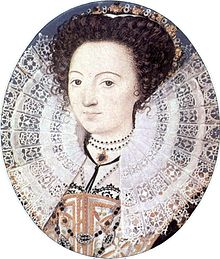Aemilia Lanyer
| Emilia Lanier | |
|---|---|

portrait by Nicholas Hilliard
|
|
| Born |
Aemilia Bassano 1569 Bishopsgate |
| Died | 1645 London, England |
| Movement | English Renaissance |
| Parent(s) | Baptiste Bassano; Margret Johnson |
Emilia Lanier (also spelled Lanyer) (1569–1645), née Bassano, was the first Englishwoman to assert herself as a professional poet through her single volume of poems, Salve Deus Rex Judaeorum (1611).
Born Aemilia Bassano, she was a member of the minor gentry through her father's appointment as a royal musician, and was apparently educated in the household by Susan Bertie, Countess of Kent. She was for several years the mistress of Henry Carey, 1st Baron Hunsdon, first cousin of Elizabeth I of England. In 1592 she became pregnant by Hunsdon, but married her first cousin, court musician Alfonso Lanier; this marriage was reportedly unhappy.
Emilia Lanier's life is well documented for the period through her letters, her poetry, her medical records, her legal records and through sources about the social contexts she inhabited. Researchers have used entries in astrologer Dr. Simon Forman's (1552–1611) professional diary, the first casebook kept by an English medical practitioner, which logs interactions with Lanier. Lanier visited Forman many times during 1597 for consultations that incorporated astrological readings, as was usual for the period. Forman was evidently sexually interested in her but was rebuffed.
Church records show that Lanier was baptised Aemilia Bassano at the parish church of St. Botolph, Bishopsgate, on 27 January 1569. Her father, Baptiste Bassano, was a Venice-born musician at the court of Elizabeth I. Her mother was Margret Johnson (born ca. 1545–1550), possibly the aunt of court composer Robert Johnson. Lanier also had a sister, Angela Bassano, who married Joseph Hollande in 1576. There were also brothers Lewes and Phillip, both of whom died before they reached adulthood. It has been suggested that Lanier's family were Jewish or of partial Jewish ancestry, though this is disputed. Susanne Woods says that evidence for Lanier's Jewish heritage is "circumstantial but cumulatively possible". Leeds Barroll says she was "probably a Jew", her baptism being "part of the vexed context of Jewish assimilation in Tudor England".
...
Wikipedia
